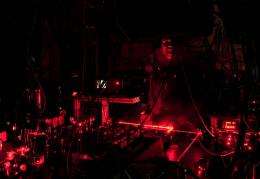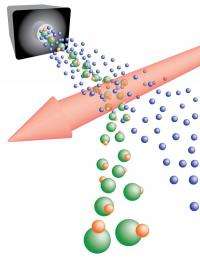December 7, 2009 feature
Using lasers to cool and manipulate molecules

(PhysOrg.com) -- "For years, we have been using laser cooling to trap and manipulate atoms," David DeMille tells PhysOrg.com. "This has been very useful for both basic science and many applications. Recently there has been great interest in cooling and trapping molecules as well. Their rich internal structure makes molecules useful for a wide range of new experiments and possible applications."
Of course, the complexity that makes molecules interesting also makes them more difficult to manipulate than atoms. Using lasers to cool molecules, therefore, comes with its own set of problems. DeMille, a scientist at Yale University, believes that a solution may have been found. He has been working with Yale colleagues Edward Shuman, John Barry and David Glenn to come up with a viable method of laser cooling for molecules. Their ideas and preliminary experimental results on the subject can be found in Physical Review Letters: “Radiative Force from Optical Cycling on a Diatomic Molecule.”
“Arguably the most difficult part of cooling molecules is trying to apply a force that opposes the molecule’s velocity. For atoms, this is accomplished using the Doppler effect. A moving atom sees incident light at a Doppler-shifted frequency. By the appropriate choice of laser frequency, you can ensure that the atom preferentially absorbs photons opposing its motion.” DeMille says. “The atom receives a small kick along the laser beam from each photon it absorbs, then emits its own photon in a random direction. This cycle returns the atom to its original state, but on average it has been slowed down a little. Do this some tens of thousands of times, and you can slow an atom enough for it to be trapped and manipulated.”

With molecules, though, things become tricky. The emission of a photon typically sets a molecule to rotating or vibrating. “They don’t return to the same state they started in,” DeMille explains. “The frequency of the laser is no longer correct for its photons to be absorbed by the molecules.” In order to get around this problem, the team at Yale built on a couple of different ideas. He says that Michael di Rosa of Los Alamos National Laboratory pointed out several years ago that certain molecules were not likely to begin vibrating, so that they could be used. However, di Rosa’s scheme would take at least six different lasers working at the same time such that the rotating (and occasionally vibrating) molecules would all absorb photons. A recent idea came from Jun Ye’s group at JILA, who pointed out that some classes of molecules could avoid vibration and rotation, but in these molecules the time needed to complete an absorption-emission cycle would be so long that slowing and cooling would be inefficient.
“We took elements of these two ideas,” DeMille says, “and combined them. We looked at situations where you could have the best of both schemes and picked what should be the easiest case.” Using strontium monofluoride, the team at Yale was able to experimentally demonstrate a scheme for optical cycling in this diatomic molecule using two diode lasers, which are common and inexpensive. “We deflected a beam of molecules using a large number of photon kicks from the laser, which is an important step toward laser cooling.”
Based on these results, lasercooling of strontium monofluoride should be within reach. “We suggest that by adding one more of these simple diode lasers, we should be able to take it the next level and actually cool the molecules. Our calculations show it should work, and we are in the process of experimenting with it now.”
More information: Shuman, Barry, Glenn and DeMille, “Radiative Force from Optical Cycling on a Diatomic Molecule,” Physical Review Letters (2009). Available online: http://link.aps.org/doi/10.1103/PhysRevLett.103.223001.
Copyright 2009 PhysOrg.com.
All rights reserved. This material may not be published, broadcast, rewritten or redistributed in whole or part without the express written permission of PhysOrg.com.















